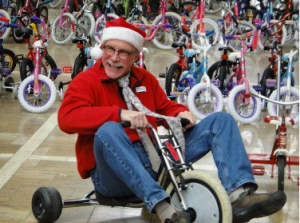 I’m the guy on the trike. Bicycling and ham radio are my things.
I’m the guy on the trike. Bicycling and ham radio are my things.
My radio career began when my high school shop teacher started a radio club back in 1965. We had to pass the Novice ticket to get an A in the class. This was also the high time of Heathkit. I learned how to solder building an HW-8 and an SB-line station once I upgraded to General. I rarely operated since I couldn’t put up much of an antenna at home but I built and built and built. I convinced a lot of the neighbors and relatives to get Heathkit stereos which I built for them (for a small fee, of course). After high school, all this led to a couple of electrical engineering degrees (and an Extra ticket) and lots and lots of operating at university club stations when I really should have been studying. Back then I operated mostly low power QRP CW.
After graduation, a job with Intel got me to the west coast. Easy access to microprocessor chips (8080 and 8048 families) with cosmetic defects allowed me to build some of the first microprocessor-based RTTY and CW equipment (all in assembly language). When CPM (an early microprocessor operating system) came out I jumped into programming. This led to a job in Intel’s microprocessor group in the 8086 days right before IBM announced the IBM PC. In the late 70s I volunteered for a 2-year European assignment in Brussels. It was fun being on the other end of pile-ups for a change (as an ON8). The job meant a lot of traveling all over Europe so I didn’t operate as much as I would have liked.
After Europe came Portland (the weather is similar). I operated the digital modes (RTTY and packet) almost exclusively and wrote a number of packet-based database applications such as a SwapNet BBS system. Then kids happened. And I went back to school for a teaching degree, taught for a couple of years and then started an Internet business. Ham radio went to the back burner. Even so, there was always a VHF radio in the car, an HF radio on the desk and a handheld in the back pack. Fast-forward 15 years and semi-retirement allowed me to blow the dust out of the old radios. An interest in emergency communication led to an intersection of ARES and Red Cross. Current projects are getting the radio shack off the grid, improving the bicycle mobile setup and getting everyone in the house licensed.